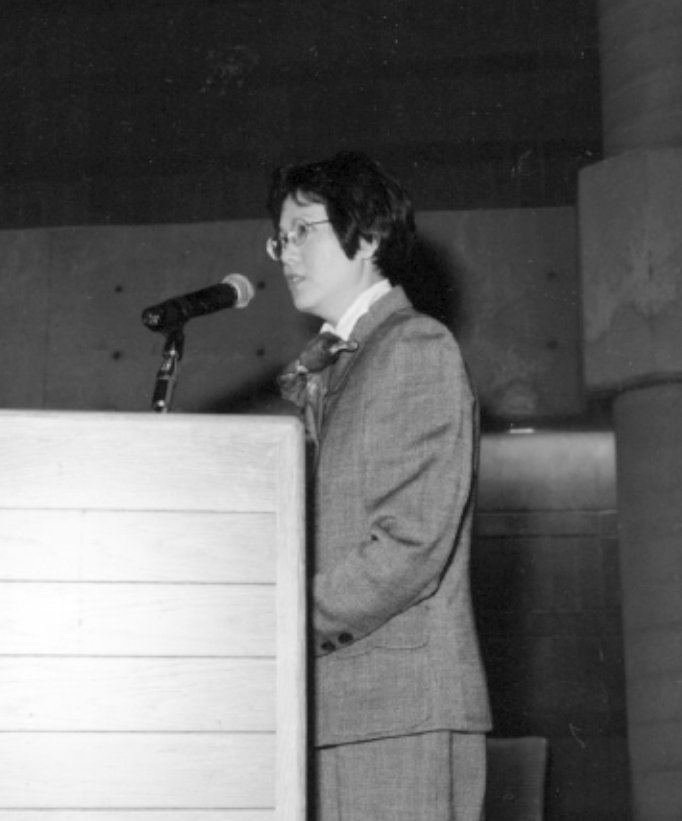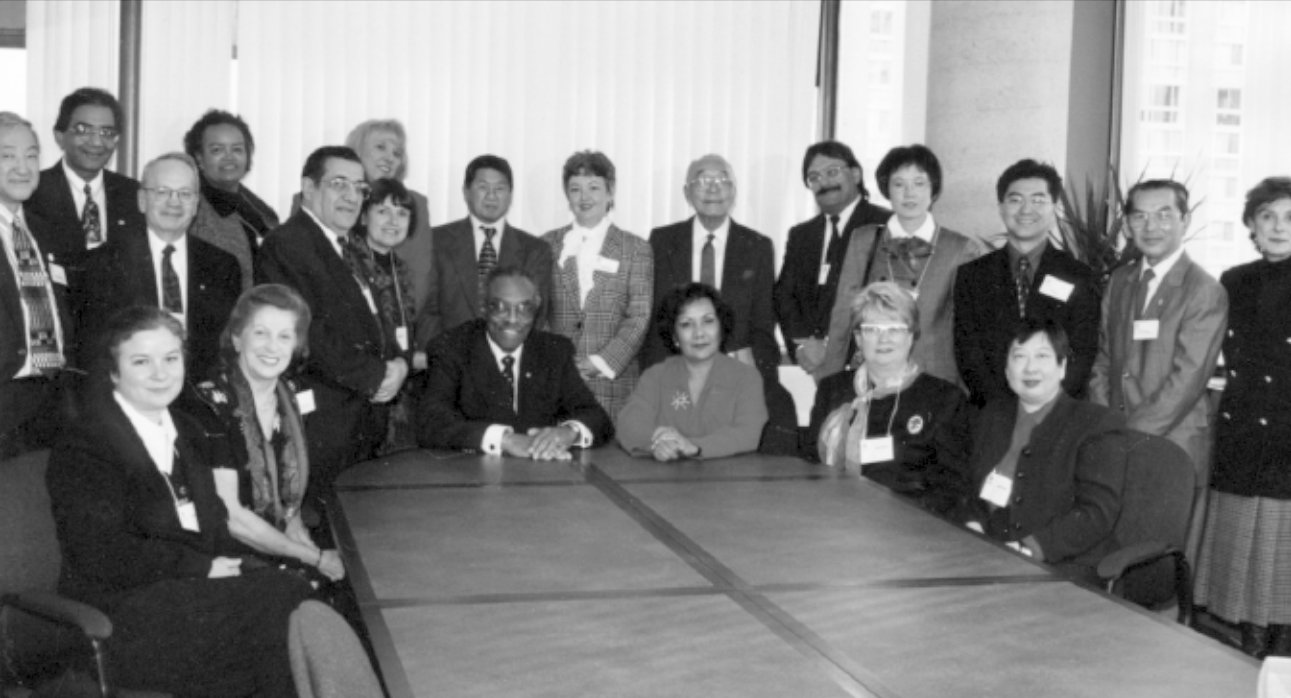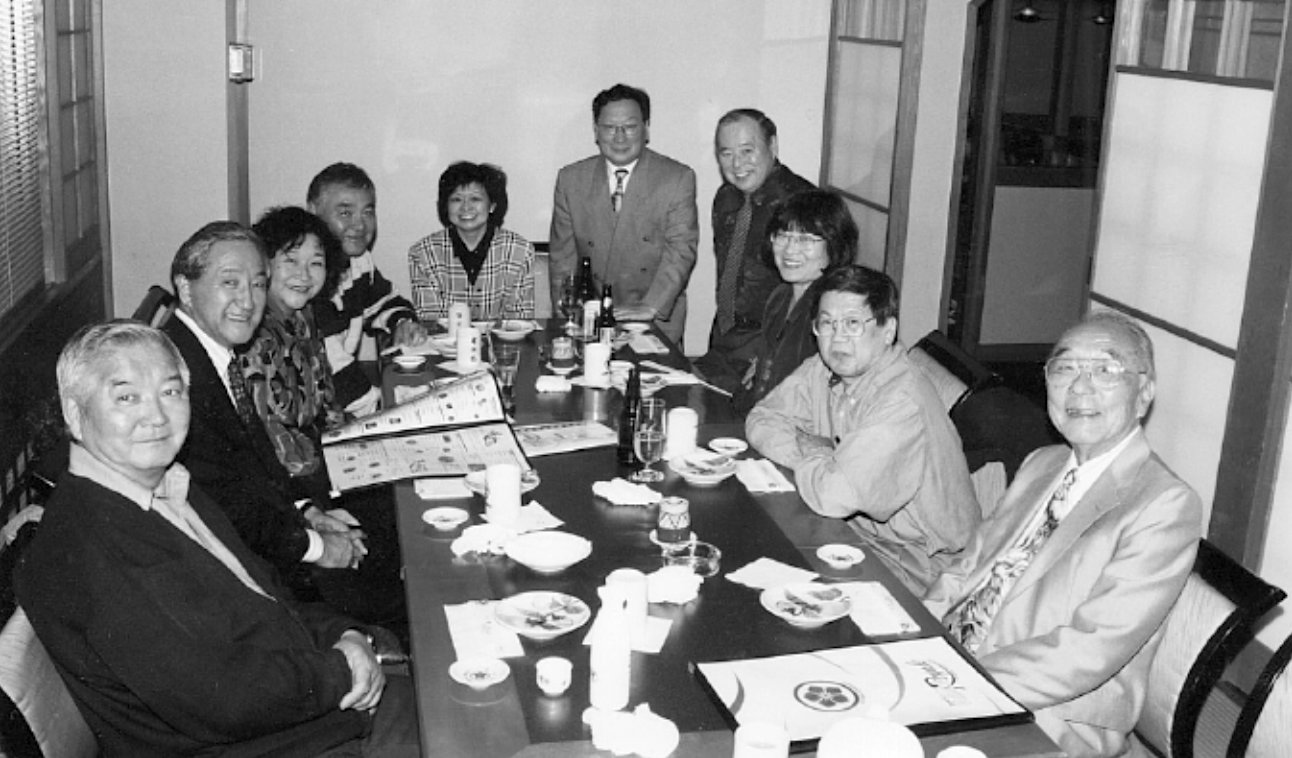Chapter 17
Benefits of Redress
By Roy Ito
The Redress Agreement of September 22, 1988 stipulated a $12 million dollar fund for the Japanese Canadian community to be administered by the National Association of Japanese Canadians (NAJC) for activities to promote the educational, social and cultural well being of the community. The NAJC established the Japanese Canadian Redress Foundation (JCRF) that has distributed over $17,000,000 so far in grants to community groups, individuals and institutions.
Japanese Canadian Redress Foundation
The following members of our community were on the Board of Directors in 1998: Dr. Henry Shimizu, Dick Nakamura, Fred Yada, Irene Nemeth, Roy Inouye, Art Miki, Lucy Yamashita, Marcia Matsui, Connie Sugiyama, Roger Obata, Fred Kamibayashi and executive director, Tony Tamayose.
The many capital projects undertaken were unimaginable prior to the Redress Agreement. Some of the larger projects included the expansion of Japanese cultural centre buildings in Toronto and Vernon, the Vancouver Japanese Language School, the Nipponia Home for Seniors—and the construction of the Momiji Seniors Centre in Toronto and Nikkei Place in Vancouver, a multi-faceted facility that includes a cultural centre, seniors’ housing and a health centre.
The Japanese Canadian Redress Foundation has also funded the construction of cultural centre buildings in Hamilton, Montreal, Ottawa, Thunderbay, Winnipeg, Edmonton, Calgary, Kamloops and Victoria. In addition, the JCRF has provided grants to create the Hastings Park Gardens, the New Denver Japanese Canadian Museum, the Tashme Japanese Gardens in Hope and the National Japanese Canadian Museum and Archives.
The significance of the Community Fund created by the Redress Agreement is that $12 million was allocated to the fund, but this amount—astutely invested by the Japanese Canadian Redress Foundation (JCRF) while being distributed to various groups and individuals— grew to more than $17 million by January 1998. The breakdown of the distribution is as follows:
| Programs | Amount | Capital Projects |
|---|---|---|
| a. Cultural | $ 1,453,723 | |
| b. Educational | 1,801,912 | |
| c. Human Rights | 83,350 | |
| d. Special Services | 417,000 | |
| e. NAJC Outreach | 500,000 | $ 12,956,351 |
| $ 4,255,985 + | $ 12,956,351 = $17,212,236.00 | |
The amazing result of this distribution by the JCRF is that the $17 million created an additional $66 million in community fundraising and personal donations so that in total the Community Fund had grown to $83 million in actual benefit to the community. This in itself was an incredible benefit derived from the Redress Agreement for all Japanese Canadians.
In addition, the JCRF provided funds to establish three Endowment Funds under the supervision of the NAJC where only the interest from the capital is used to provide annual grants. The three Endowment Funds are Cultural Development ($550,000), Sports-Education-Arts (SEAD) ($250,000) and National Development ($300,000).
During the past ten years, the JCRF has distributed grants to various individuals and groups for smaller projects. There were 48 books and history grants, 29 artistic exhibits and conference grants, six stage plays, nine films and videos, six social service programs and three oral history grants.
Some of the programs funded by the JCRF that developed into recognized and successful projects were Linda Ohama’s film, The Last Harvest, which won a number of awards at various film festivals and has been shown internationally, Kerri Sakamoto’s novel, The Electrical Field, which has gained international acclaim in Europe and the United States, as well as in Canada, Roy Ito’s fascinating book on Japanese Canadians, Stories of My People—and two valuable books on Redress: Bittersweet Passage by Maryka Omatsu and Justice in Our Time by Roy Miki and Cassandra Kobayashi.
No doubt there will be other projects that received grants from the JCRF—projects that will prove to have lasting benefit for the Japanese Canadian community in particular and historical value for the general public. Such achievements, along with the major capital grants, will certainly ensure the success of the JCRF in fulfilling its mandate to rebuild the community.
Toronto area grant recipients included the NAJC Toronto Chapter, Momiji Seniors Centre, the Japanese Canadian Cultural Centre, Nikkei Voice and Nipponia Home in Beamsville, Ontario.
NAJC Toronto Chapter
The $400,000 grant from the JC Redress Foundation to the Toronto Chapter gave reality to the dream of a permanent home for NAJC members in Toronto. As Blanche Hyodo states, “We were determined not to incur a mortgage as it was clear from our past rent-paying days that the Chapter did not have the finanicial resources to handle monthly mortgage payments along with the daily operational costs usually associated with operating a non-profit organization. Although far from being our first choice, 382 Harbord Street, a former store, was available for approximately $200,000 and since it was centrally located, we purchased it in the early months of 1993. We were aware that extensive renovations would be required to make it operational. Architect David Fuiiwara was contracted to redesign the interior structure from scratch, adding a kitchen, washrooms, offices and a wheel chair access ramp.” Through his 100-page long “Feasibility Report”, David Fujiwara was also largely responsible for convincing the Foundation to grant the money for the purchase and renovation.
Van Hori recalls that the Harbord Street location was a vast improvement over their initial permanent location at 165 Spadina Avenue where they had a month-to-month rental arrangement: “Our office was located on the fourth floor with Chris Kurata’s office just down the hallway. I remember that moving furniture and office equipment in and out was very difficult because there was no elevator. During meetings some members had to sit outside the office in the hallway. The room was a square with a tiny little room off to the right where we set up the computer on a table made by Yo Mori to fit into the space.”
By November 1993, the NAJC Toronto Chapter moved into its new home, which was officially named, “NAJC Friendship House”. With this new permanent home, the chapter no longer had to rely on any other organization for space to hold meetings, book launches, art exhibits, etc.. Instead of being a cubicle in an impersonal office building, the NAJC Friendship House could be a welcoming place on the street level, clearly visible to the public in an accessible downtown location.
It should be noted that the NAJC Toronto Chapter maintained a high profile in the area of human rights for several years following the Redress Settlement. One of its first efforts to promote human rights and intercultural communication was the Earth Spirit Festival at Toronto’s Harbourfront which brought together visual and performing artists from the Japanese Canadian and Aboriginal cultures. There was also representation from the Ainu community of Japan. In addition, the NAJC Toronto Chapter established links with the Toronto Jewish community, offering support when Jewish headstones and synagogues were the targets of racist defacement. Sensitive to the issue of racism, the Toronto chapter filed an official complaint regarding a negative Japanese stereotype in a “Nibs” candy TV commercial and the commercial was withdrawn. The Toronto chapter was also involved in the formation of a “National Coalition of Redress” aimed at securing Redress from the government for Ukrainian Canadians, Italian Canadians and Chinese Canadians. This spirit of solidarity among Toronto’s ethnic communities was nurtured during the Redress campaign and continued to grow through NAJC representation at various human rights demonstrations and on committees in Toronto such as the Urban Alliance on Race Relations.
Momiji Seniors Centre
The Momiji Health Care Society was incorporated in 1978. It began in 1975 as the JCCA Committee for Elderly Care. After many years of searching for appropriate land, the current location at the intersection of Kingston Road and Markham Road in Scarborough was purchased in 1990. The sod turning was held on March 15, 1991. Then in December of the following year the Momiji Seniors Centre became a reality when the first tenants were admitted. The Momiji Seniors Centre has 133 one and two bedroom apartments as well as a large common area that includes an auditorium, crafts room, a day lounge, an atrium, a boardroom, a library, a restaurant, a chapel, a fitness room, an aquatic centre, a grocery store and a hair salon. Thus, there is a wonderful sense of community at Momiji with various organized daily cultural and social activities for the residents. The total cost of the Momiji Seniors Centre was $23.5 million. The Japanese Canadian Redress Foundation made an initial contribution of $1.15 million.
Japanese Canadian Cultural Centre
There was a tinge of sadness with the announcement on December 10, 1996, that the Japanese Canadian Cultural Centre (JCCC) on Wynford Drive, designed by Raymond Moriyama, would be sold and that a new centre would be acquired at a neighbouring location, one bus stop away from the old centre. Officially opened in May 1999, the new centre is five times larger than the old facility. It has received both financial and political support from the former City of North York, the province of Ontario, the former Metropolitan Toronto government, the Toronto Association of Japanese Industry and Commerce, the Osaka Foundation through the Consulate of Japan—and the Japanese Canadian Redress Foundation. The JCRF provided an initial grant of $800,000 with an additional $450,000 for renovations. As well, the Centre has relied on the financial support of the membership and the Japanese Canadian community.
Many Toronto JCs felt sentimentally attached to the old 123 Wynford Drive Centre designed by Raymond Moriyama for it was the heart of cultural activities in our community for over 30 years, but as JCCC president, Sid Ikeda, stated when announcing the change, the new facility represents a step forward towards a much larger vision for the future JCCC: “As we near the end of another year and move closer towards year 2000 and beyond, it is with great respect, admiration and honour that we reflect upon the accomplishments and memories of our first generation—the issei and the second generation—the nisei as community builders…”1
Nikkei Voice
Dr. Wes Fujiwara launched Nikkei Voice, first published in 1987, in Toronto. As Frank Moritsugu notes in a 1995 issue of Nikkei Voice, “Nikkei Voice’s first publisher and generous godfather was Dr. Wes Fujiwara, who oversaw the transition of the paper from the original NAJC Newsletter. He fought the early battles to make this publication viable. He financed our converting to computers. And he enabled the editors to put out bigger and better issues as the years went along.”2
The driving force behind Nikkei Voice was Joy Kogawa who persuaded many other Japanese Canadians to share her dream of a national newspaper to bring together the widely dispersed Japanese Canadian community. Joy Kogawa, Frank Moritsugu and Ken Adachi served as the paper’s first editorial advisors. Today the editorial staff consists of Jesse Nishihata, Yusuke Tanaka and Sadako Jokura. Before Nishihata became editor in November 1991, David Ikeda, Suzanne Hartman, Jennifer Hashimoto and Ken Kishibe handled editorial duties. After Wes and Misao Fujiwara moved to B.C., Terry Watada took over as executive director for four years, followed by Frank Moritsugu, the current publisher. Deidre Tanaka, a professional translator, has also been actively involved in the newspaper over the past ten years.
Nikkei Voice received a one-time grant of $122,000 from the Japanese Canadian Redress Foundation. At one time the paper was mailed to all Japanese Canadian homes free of charge, but with the depletion of the grant, circulation is now for subscribers only.
Nipponia Home
Yasutaro Yamaga, a respected business leader and former vice president of the B.C. Parent Teachers’ Association, founded Nipponia Home. After the JC expulsion, he settled in Hamilton, Ontario. After selling his own home, he donated $25,000 to start the Nipponia Home in December 1958, an 18-bed home in Beamsville, Ontario for elderly Japanese Canadians. Yamaga’s cousin, Tomiyo Uyehara, donated another $10,000 and 852 other donors, mostly issei, contributed another $17,000. In 1993, the Yamaga Wing was added to the facility and other improvements were made to ensure that the residents could live the rest of their lives there more comfortably. The total cost of the renovation was $1,549,496. The Japanese Canadian Redress Foundation contributed a grant of $350,000. The Ontario government donated $750,000. The balance was funded by individual donations from the Japanese Canadian community.
The Canadian Race Relations Foundation
The tragic experience of the expulsion of Canadian citizens of Japanese ancestry from B.C. under government orders necessitated the Redress Agreement of September 22, 1988. The trauma of what Japanese Canadians went through was clearly the result of institutionalized racism. In an effort to recognize this fact and ensure that such a travesty of justice never occurs again in this country, the Redress Agreement included the establishment of a Canadian Race Relations Foundation (CRRF).
The Honourable Hedy Fry, Secretary of State for Multiculturalism and the Status of Women, officially announced the CRRF in Toronto on October 29, 1996, a day after it was proclaimed in the House of Commons. It was established with a total endowment of $24 million dollars, equally funded by the NAJC and the Government of Canada. When the NAJC negotiating team agreed to the CRRF as part of our Redress package back in August 1988, it was on the understanding that the CRRF would abide by the following conditions:
- The CRRF is to actively combat racism so that what happened to the Japanese Canadians during the war may never be repeated;
- The CRRF is to be an autonomous body totally independent of the government and free to criticize government action where necessary, on violations of human rights and race relations;
- The CRRF is to provide funds for research and education on issues related to combatting race discrimination.
- Representation on the Board of Directors is to be appropriate in relation to the financial contribution.
The Canadian Race Relations Foundation (CRRF) was officially opened on November 13, 1997 at its Toronto location, 4900 Yonge Street, Suite 1305. Presiding over the opening ceremony was the Honourable Lincoln M. Alexander, chairperson of the foundation and former lieutenant governor of Ontario. Also present was Moy Tam, the executive director, and Art Miki.
Time will be the judge as to whether or not the Foundation has fulfilled its original objectives. Some members of the NAJC Toronto Chapter have publicly expressed some skepticism about the current composition of the CRRF Board of Directors. At present, Art Miki is the only member of the Japanese Canadian community on the Board. The other members have been hand picked by the government. Given this fact, it is hoped that the CRRF can still fulfill its commitment to combat racism in an impartial way free of government interference.

The Momiji Seniors Centre located at the corner of Kingston Rd. and Markham Rd. in Scarborough, is a modern facility containing 133 apartments as well as an auditorium, an atrium, a restaurant, a grocery store and various other conveniences. Construction of the building began with a contribution of $1.15 million from the Japanese Canadian Redress Foundation. (Photo: Tosh Omoto)

Japanese Language Editor Yusuke Tanaka (left) and Managing Editor Jesse Nishihata (right) taking a short break from their hectic schedule in the former office of Nikkei Voice, on the second floor of the NAJC Friendship House on Harbord St in Toronto. Yusuke has been with Nikkei Voice since September 1989, and Jesse since October 1991. Nikkei Voice now operates out of the new Japanese Canadian Cultural Centre at 6 Garamond Court. (Photo courtesy Blanche Hyodo)

Nipponia Home, a facility for elderly JCs, was established by Yasutaro Yamaga in 1958 in Beamsville, Ontario. A major renovation of Nipponia Home took place in the mid1990s with a grant of $350,000 from the Japanese Canadian Redress Foundation, a contribution of $750,000 from the Ontario government as well as individual donations. Jack Oki, a longtime executive member and chairman of the Board of Directors, is pictured above (centre right in the dark suit) at the official sod turning with other members of the Board. Below: the grand opening. (Photos courtesy Roger Obata)


The old Japanese Canadian Cultural Centre, 123 Wynford Drive in the Don Mills area of Toronto. (Photo: Harry Yonekura)

Toronto’s new Japanese Canadian Cultural Centre, 6 Garamond Court. Officially opened in May 1999, it is located just a very short distance away from the Wynford Drive building. (Photo: Harry Yonekura)

NAJC Friendship House, 382 Harbord St., Toronto, just after completion of renovations, November 1993. (Photo: Blanche Hyodo)

MOY TAM, a Chinese Canadian born in Brunei on the island of Borneo, came to Canada as a teenager. After completing her B.Sc. in Environmental Studies from York University, Ms. Tam went on to receive her M.A. She is the first executive director of the Canadian Race Relations Foundation where she heads a permanent staff of five. In distributing the funds of the foundation to specific projects related to combatting racism, she feels that it is important to spend the money where it is most needed and, above, all not to duplicate efforts. (Photo courtesy Blanche Hyodo)

The Board of Directors of the Canadian Race Relations Foundation and members of the NAJC. Seated at the end of the table are the Hon. Lincoln Alexander (CRRF chairman), the Hon. Hedi Fry, Susan Scotti, Director General of the Canadian Heritage Foundation, is the first person on the right. (Photo courtesy Canadian Race Relations Foundation)

Board of Directors, Japanese Canadian Redress Foundation, August 1996. Left to right around table: Roy Inouye, Fred Kamibayashi, Irene Nemeth, Tony Tamayose, Lucy Yamashita, Henry Shimizu, Dick Nakamura, Marcia Matsui, Art Miki and Roger Obata. (Photo courtesy Roger Obata)